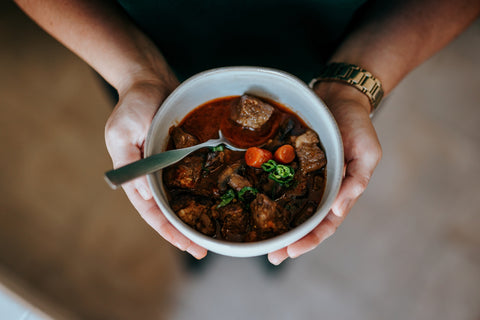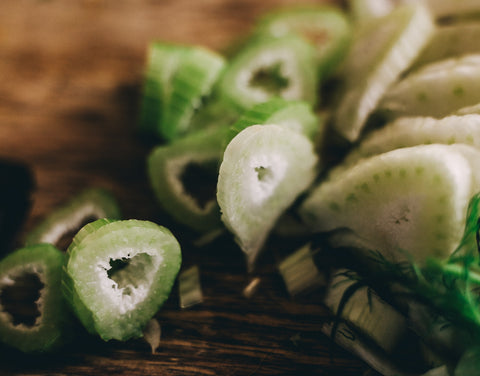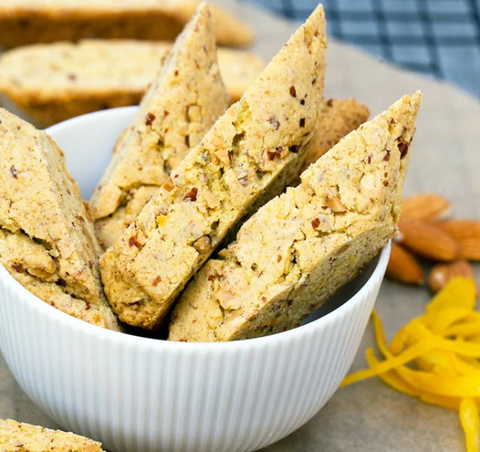INGREDIDENTS

Sunchokes, aka Jerusalem Artichokes, are not from Jerusalem and they are not artichokes. They are a species of sunflower native to North America. They grow as an edible tuber or underground stem of a plant that is part of the daisy family. Italian settlers in the United States called the plant girasole, the Italian word for sunflower. Speculation is “Jerusalem” somehow derived from mispronouncing or misunderstanding this name.
Sunchokes resemble a small knobby potato or a very large ginger root. They can be light brown to yellow or have a purple tinge. They are sweet, crunchy and nutty tasting when raw and can substitute for water chestnuts in salads. Caveat: sunchokes are a rich source of inulin, a polysaccharide that is handled by the body differently from other sugars. For those sensitive to gas producing foods, like beans, try them in small amounts initially. Eating sunchokes raw may cause gastric distress in some people. Fortunately, cooking mitigates this problem and everyone can enjoy them once cooked. Sunchokes are a good source of iron and potassium, better than bananas for potassium! They are low in calories and high in fiber.
Sunchokes are available in the produce section of most supermarkets and are found at Farmers' Markets usually from October through March and April. Choose tubers that are smooth, clean, and plump. They do not need to be peeled but should be scrubbed thoroughly under cold water with a vegetable brush. Once cut, the flesh will darken with exposure to air, so prepare them close to serving time or immerse them in water with a squeeze of lemon.

Sunchokes can be mashed just like potatoes or added to potatoes. They can be used to thicken soups or stews and become caramelized and delicious when roasted with olive oil. They can be substituted for turnips or parsnips in any recipe.
McEvoy Ranch hosted a Fresh Start workshop where I shared some recipes for Bone Broth and Mineral Broth and discussed the health-giving properties of homemade soup. Several garnishes were offered for the soup to enhance flavor and nutrition. The runaway favorite garnish was sunchoke chips and I wanted to share some tips so you can try them yourselves.
I scrubbed the sunchokes as described above. Here they are nice and clean. Remember - no need to peel them. Aren’t you glad?

Slice them on a mandolin. See the little plastic piece in front of the mandolin? That is the carrier or holder for whatever you are slicing. Mandolin blades are very sharp and it is easy to get distracted for a moment and cut yourself. Use the carrier or wear a cut glove to protect your fingers. When I was teaching in culinary school, we always required students to use a cut glove when they were working with the mandolin. You can thank me later ...


Then, I fried them in
McEvoy Ranch Extra Virgin olive oil.
Be sure your oil is hot enough by testing a slice. If, when you add the slice to the pan, it bubbles immediately and pops back up to the surface, you are good to go.
The slices, unlike potatoes when you are making chips, are very forgiving. They do not stick together and as long as you stir them occasionally, they finish by staying on the surface when they are lightly browned. It’s like they are alerting you that they are done. Remove them from the oil with a skimmer or slotted spoon and let them drain on a paper towel. Sprinkle lightly with sea salt.
Sunchokes aka Jerusalem Artichokes are a crunchy yummy snack as well as a soup garnish. The flavor is intriguing and addictive. Challenge your friends to see if they can guess what they are munching!

 Sunchokes, aka Jerusalem Artichokes, are not from Jerusalem and they are not artichokes. They are a species of sunflower native to North America. They grow as an edible tuber or underground stem of a plant that is part of the daisy family. Italian settlers in the United States called the plant girasole, the Italian word for sunflower. Speculation is “Jerusalem” somehow derived from mispronouncing or misunderstanding this name.
Sunchokes resemble a small knobby potato or a very large ginger root. They can be light brown to yellow or have a purple tinge. They are sweet, crunchy and nutty tasting when raw and can substitute for water chestnuts in salads. Caveat: sunchokes are a rich source of inulin, a polysaccharide that is handled by the body differently from other sugars. For those sensitive to gas producing foods, like beans, try them in small amounts initially. Eating sunchokes raw may cause gastric distress in some people. Fortunately, cooking mitigates this problem and everyone can enjoy them once cooked. Sunchokes are a good source of iron and potassium, better than bananas for potassium! They are low in calories and high in fiber.
Sunchokes are available in the produce section of most supermarkets and are found at Farmers' Markets usually from October through March and April. Choose tubers that are smooth, clean, and plump. They do not need to be peeled but should be scrubbed thoroughly under cold water with a vegetable brush. Once cut, the flesh will darken with exposure to air, so prepare them close to serving time or immerse them in water with a squeeze of lemon.
Sunchokes, aka Jerusalem Artichokes, are not from Jerusalem and they are not artichokes. They are a species of sunflower native to North America. They grow as an edible tuber or underground stem of a plant that is part of the daisy family. Italian settlers in the United States called the plant girasole, the Italian word for sunflower. Speculation is “Jerusalem” somehow derived from mispronouncing or misunderstanding this name.
Sunchokes resemble a small knobby potato or a very large ginger root. They can be light brown to yellow or have a purple tinge. They are sweet, crunchy and nutty tasting when raw and can substitute for water chestnuts in salads. Caveat: sunchokes are a rich source of inulin, a polysaccharide that is handled by the body differently from other sugars. For those sensitive to gas producing foods, like beans, try them in small amounts initially. Eating sunchokes raw may cause gastric distress in some people. Fortunately, cooking mitigates this problem and everyone can enjoy them once cooked. Sunchokes are a good source of iron and potassium, better than bananas for potassium! They are low in calories and high in fiber.
Sunchokes are available in the produce section of most supermarkets and are found at Farmers' Markets usually from October through March and April. Choose tubers that are smooth, clean, and plump. They do not need to be peeled but should be scrubbed thoroughly under cold water with a vegetable brush. Once cut, the flesh will darken with exposure to air, so prepare them close to serving time or immerse them in water with a squeeze of lemon.
 Sunchokes can be mashed just like potatoes or added to potatoes. They can be used to thicken soups or stews and become caramelized and delicious when roasted with olive oil. They can be substituted for turnips or parsnips in any recipe.
McEvoy Ranch hosted a Fresh Start workshop where I shared some recipes for Bone Broth and Mineral Broth and discussed the health-giving properties of homemade soup. Several garnishes were offered for the soup to enhance flavor and nutrition. The runaway favorite garnish was sunchoke chips and I wanted to share some tips so you can try them yourselves.
I scrubbed the sunchokes as described above. Here they are nice and clean. Remember - no need to peel them. Aren’t you glad?
Sunchokes can be mashed just like potatoes or added to potatoes. They can be used to thicken soups or stews and become caramelized and delicious when roasted with olive oil. They can be substituted for turnips or parsnips in any recipe.
McEvoy Ranch hosted a Fresh Start workshop where I shared some recipes for Bone Broth and Mineral Broth and discussed the health-giving properties of homemade soup. Several garnishes were offered for the soup to enhance flavor and nutrition. The runaway favorite garnish was sunchoke chips and I wanted to share some tips so you can try them yourselves.
I scrubbed the sunchokes as described above. Here they are nice and clean. Remember - no need to peel them. Aren’t you glad?
 Slice them on a mandolin. See the little plastic piece in front of the mandolin? That is the carrier or holder for whatever you are slicing. Mandolin blades are very sharp and it is easy to get distracted for a moment and cut yourself. Use the carrier or wear a cut glove to protect your fingers. When I was teaching in culinary school, we always required students to use a cut glove when they were working with the mandolin. You can thank me later ...
Slice them on a mandolin. See the little plastic piece in front of the mandolin? That is the carrier or holder for whatever you are slicing. Mandolin blades are very sharp and it is easy to get distracted for a moment and cut yourself. Use the carrier or wear a cut glove to protect your fingers. When I was teaching in culinary school, we always required students to use a cut glove when they were working with the mandolin. You can thank me later ...

 Then, I fried them in McEvoy Ranch Extra Virgin olive oil.
Be sure your oil is hot enough by testing a slice. If, when you add the slice to the pan, it bubbles immediately and pops back up to the surface, you are good to go.
The slices, unlike potatoes when you are making chips, are very forgiving. They do not stick together and as long as you stir them occasionally, they finish by staying on the surface when they are lightly browned. It’s like they are alerting you that they are done. Remove them from the oil with a skimmer or slotted spoon and let them drain on a paper towel. Sprinkle lightly with sea salt.
Sunchokes aka Jerusalem Artichokes are a crunchy yummy snack as well as a soup garnish. The flavor is intriguing and addictive. Challenge your friends to see if they can guess what they are munching!
Then, I fried them in McEvoy Ranch Extra Virgin olive oil.
Be sure your oil is hot enough by testing a slice. If, when you add the slice to the pan, it bubbles immediately and pops back up to the surface, you are good to go.
The slices, unlike potatoes when you are making chips, are very forgiving. They do not stick together and as long as you stir them occasionally, they finish by staying on the surface when they are lightly browned. It’s like they are alerting you that they are done. Remove them from the oil with a skimmer or slotted spoon and let them drain on a paper towel. Sprinkle lightly with sea salt.
Sunchokes aka Jerusalem Artichokes are a crunchy yummy snack as well as a soup garnish. The flavor is intriguing and addictive. Challenge your friends to see if they can guess what they are munching!



